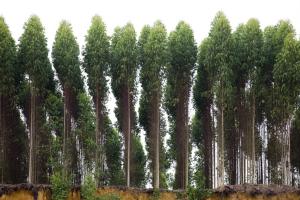Everyone now seems to agree that the Earth’s climate is changing as a direct result of human activities and that the social, environmental, political and economic consequences will be catastrophic if nothing is done – and fast – to address the problem.
Large-Scale Tree Plantations
Industrial tree plantations are large-scale, intensively managed, even-aged monocultures, involving vast areas of fertile land under the control of plantation companies. Management of plantations involves the use of huge amounts of water as well as agrochemicals—which harm humans, and plants and animals in the plantations and surrounding areas.
Bulletin articles
30 October 2006
The World Bank has become the main international trader of carbon credits. Its new role gives rise to a series of conflicting interests.
Bulletin articles
30 October 2006
The 9th Conference of the Parties of the United Nations Convention on Climate Change held in Milan in 2003 allowed Northern companies and governments to establish plantations in the South under the Kyoto Protocol’s “Clean Development Mechanism” (CDM), allegedly to absorb carbon dioxide and to store carbon. COP-9 allowed the use of plantations of genetically engineered (GE) trees [also known as genetically modified, GM, or transgenic trees] as carbon sinks, that is to supposedly offset carbon emissions
Other information
30 October 2006
I recently had the opportunity of travelling to the Indian province of West Bengal and to visit the Dhoteria, Bagora and Mayung “Forest Villages” in the districts of Darjeeling, Kurseong and Kalimpong.
To the outsider, the mountain area of the Outer Himalayas appears to be covered by dense forests, mostly composed of very large trees. However, local people know that these are not forests, but old and new plantations of mostly two species: the Japanese cedar (Cryptomeria japonica) and Teak (Tectona grandis).
Other information
30 October 2006
Later this year, United Fiber Systems plans to open a new 700,000 tonnes a year wood chip mill at Alle-Alle on the island of Pulau Laut. The mill is the first step of UFS’ proposed pulp developments for Kalimantan. The wood chips will be exported to feed pulp and paper mills in China.
Other information
30 October 2006
The International Union of Forest Research Organizations (IUFRO) conference “Forest Plantations Meeting: Sustainable Forest Management with Fast Growing Plantations” 10-13 October, 2006 encountered heavy opposition by several environmental and ecological justice groups.
Bulletin articles
30 October 2006
Last month I wrote an article about FSC certification of “village forestry” in Laos. The article was based on a leaked report from a World Bank and Finnish government project, the Sustainable Forestry and Rural Development Project (SUFORD). The SUFORD report documented serious problems with logging under the project, of which 39,000 hectares has been certified by SmartWood under the Forest Stewardship Council system.
Other information
26 October 2006
Only available in Spanish -
Por Silvia Ribeiro *
Other information
13 October 2006
By Benjamin D. Hodgdon -
Bulletin articles
30 September 2006
In 2004, the Brazilian Network campaigning against the spread of tree plantations came up with the idea of instituting an International Day Against Monoculture Tree Plantations on 21 September, which is National Tree Day in that country. The idea was supported by organizations from all over the world, who since then carry out a number of special activities on this day.
It is important to stress that this is certainly not a day aimed at opposing tree planting in general, but an activity focusing on one type of plantation in particular: large scale tree monocultures.
Bulletin articles
30 September 2006
The PEFC was set up between 1998 and 1999 by the national forestry interest groups – mainly associations of small-forest owners in several European countries as the Pan European Forest Certification Scheme. It changed to its current name after having endorsed other non-European schemes. The scheme is governed by the PEFC Council, which consists of representatives of national certification schemes and are the PEFC’s members. The PEFC is not a single certification scheme with a single standard, but a programme for the endorsement of national certification schemes.
Bulletin articles
30 September 2006
At its last Conference of the Parties (COP8), the Convention on Biological Diversity adopted a very important Decision (VIII/19), “Recommending Parties to take a precautionary approach when addressing the issue of genetically modified trees”.


